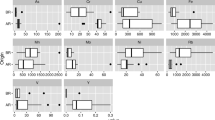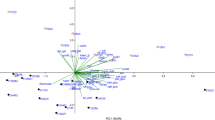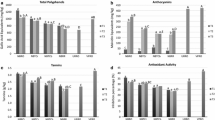Abstract
Apulian farmers have begun to explore the potential of grape juice as an alternative method to increase the profitability and stability of their farming operations. Grape juice obtained from table cultivar rich in polyphenols are considered value-added food products, so producers are interested in identifying an analytical method that permits (1) to quantify the phenolic composition, in order to select the richer variety of antioxidant substance, and (2) to trace the grape cultivar, in order to have a tool to protect their nutraceutical product from imitations. In this work, a chemometric approach, consisting of the comprehensive application of two-way full-factorial MANOVA, hierarchical cluster (HCA), and principal component analyses (PCA), is proposed as tool to differentiate seven table grape varieties (white, ‘Carati,’ ‘Sugraone,’ and ‘Italia’ and colored ‘Michele Palieri,’ ‘Summer Royal,’ ‘Autumn Royal,’ and ‘Crimson Seedless’) actually used to produce grape juice in Apulia. Anthocyanins were the main flavonoids in the colored grapes, and highly significant quantitative differences (F cultivar × vintage = 25,461; p < 0.001) in their profile were found; moreover, elevated levels of flavonols and flavan-3-ols were also quantified in all the varieties. According to HCA, cultivars were grouped into two clusters: one including ‘Michele Palieri,’ ‘Summer Royal,’ and ‘Autumn Royal,’ mainly characterized by the presence of anthocyanidins acetyl and coumaroyl glucosides, and the other formed by ‘Crimson Seedless,’ ‘Carati,’ ‘Sugraone,’ and ‘Italia,’ with relatively elevated level of procyanidins as well as quercetin and kaempferol derivatives; furthermore, PCA allowed to differentiate either ‘Michele Palieri,’ the only containing epicatechin, from the other colored cultivars, or ‘Italia,’ thanks to its higher content of quercetin-3-O-glucoside, from the other white grapes. Considering these results, the black cultivar ‘Michele Palieri’ has the highest suitability for the production of grape juice with nutraceutical properties.




Similar content being viewed by others
References
Parpinello GP, Nunziatini G, Rombolà AD, Gottardi F, Versari A (2013) Postharvest Biol Technol 83:47–53
Teissedre PL, Waterhouse AL, Walzem RL, German JB, Frankel EN, Ebeler SE, Clifford AJ (1996) Bull OIV 69:251–277
Xu C, Zhang Y, Cao L, Lu J (2010) Food Chem 119:1557–1565
Ramchandani AG, Chettiyar RS, Pakhale SS (2010) Food Chem 119:298–305
Camargo UA, Tonietto J, Hoffmann A (2011) Rev Bras Frutic 33:144–149
Rizzon LA, Miele A (2012) Food Sci Technol 32:93–97
Grandizoli CWPDS, Campos FR, Simonelli F, Barison A (2014) Quim Nova 37:1227–1232
Ghedira K (2005) Phytotherapie 3:162–169
Kamal C, Ram S, Vinay K, Sanjay K (2012) J Sci Ind Res 1:25–39
Qian Y, Agne A, Chira K, Teissèdre PL, Décordé K, Ventura E, Cristol JP, Rouanet JM (2009) Eur Food Res Technol 229:485–493
Mulero J, Pardo F, Zafrilla P (2009) Eur Food Res Technol 229:807–812
Tenore GC, Calabrese G, Stiuso P, Ritieni A, Giannetti D, Novellino E (2014) Food Res Int 63:252–257
Coimbra SR, Lage SH, Brandizzi L, Yoshida V, Da Luz PL (2005) Braz J Med Biol Res 38:1339–1347
Manach C, Scalbert A, Morand C, Rémésy C, Jiménez L (2004) Am J Clin Nutr 79:727–747
Pinelo M, Arnous A, Meyer AS (2006) Trends Food Sci Technol 17:579–590
Gómez Gallego MA, GómezGarcía-Carpintero E, Sánchez-Palomo E, Hermosín-Gutiérrez I, González Viñas MA (2012) Eur Food Res Technol 234:295–303
Versari A, Laurie VF, Ricci A, Laghi L, Parpinello GP (2014) Food Res Int 60:2–18
Bergamini C, Caputo AR, Gasparro M, Perniola R, Cardone MF, Antonacci D (2013) Mol Biotechnol 53:278–288
This P, Jung A, Boccacci P, Borrego J, Botta R, Costantini L, Maul E (2004) Theor Appl Genet 109:1448–1458
Bowers JE, Dangl GS, Vignani R, Meredith CP (1996) Genome 39:628–633
Bowers JE, Dangl GS, Meredith CP (1999) Am J Enol Vitic 50:243–246
Sefc KM, Regner F, Turetschek E, Glössl J, Steinkellner H (1999) Genome 42:367–373
Crupi P, Coletta A, Milella RA, Perniola R, Gasparro M, Genghi R, Antonacci D (2012) J Food Sci 77:C174–C181
Pati S, Crupi P, Benucci I, Antonacci D, Di Luccia A, Esti M (2014) Food Res Int 66:207–215
Guidoni S, Hunter JJ (2012) Eur Food Res Technol 235:397–408
Gómez Gallego MA, Sánchez-Palomo E, Hermosín-Gutiérrez I, González Viñas MA (2013) Eur Food Res Technol 236:647–658
Pomar F, Novo M, Masa A (2005) J Chromatogr A 1094:34–41
Makris DP, Kallithraka S, Kefalas P (2006) J Food Compos Anal 19:396–404
Monagas M, Gómez-Cordovés C, Bartolomé B, Laureano O, Ricardo da Silva JM (2003) J Agric Food Chem 51:6475–6481
Cuyckens F, Claeys M (2004) J Mass Spectrom 39:1–15
Cantos E, Espín JC, Tomás-Barberán FA (2002) J Agric Food Chem 50:5691–5696
The European Vitis Database, 2007 from: http://www.eu-vitis.de/index.php
Acknowledgments
This study was supported by grant from Apulia Region (“PS_026” Project) and Italian Ministry of University and Research-MIUR (PON “R&C”-2007-2013-Project ONEV- cod.00134/2011).
Conflict of interest
None.
Compliance with Ethics Requirements
This article does not contain any studies with human or animal subjects.
Author information
Authors and Affiliations
Corresponding author
Rights and permissions
About this article
Cite this article
Crupi, P., Bergamini, C., Perniola, R. et al. A chemometric approach to identify the grape cultivar employed to produce nutraceutical fruit juice. Eur Food Res Technol 241, 487–496 (2015). https://doi.org/10.1007/s00217-015-2478-y
Received:
Revised:
Accepted:
Published:
Issue Date:
DOI: https://doi.org/10.1007/s00217-015-2478-y




